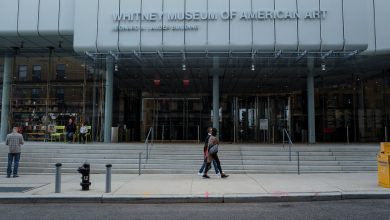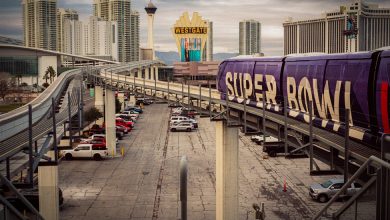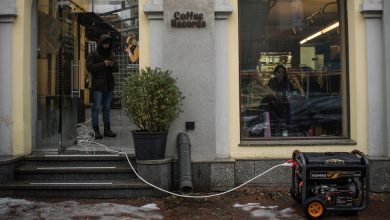A Battle Over Banning Gas and Oil Hookups in New Buildings

Good morning. It’s Tuesday. Today we’ll explore a brewing battle over Gov. Kathy Hochul’s proposal to ban gas and oil hookups in new buildings. And we’ll find out why New York City’s switch to electric vehicles from gas-burning ones is off to a sluggish start.

Credit…Dieu-Nalio Chéry for the New York Times
It might surprise you — given the share of daily angst that New Yorkers, whether they drive or not, devote to traffic and parking — that cars and trucks are not the state’s biggest contribution to climate change and its civilization-threatening risks. Buildings are.
Yes, the threat is coming from inside the house. Or to be exact, from our houses, apartments, offices, factories and shops. Across the state, 32 percent of planet-warming gases in the atmosphere comes from heating buildings and cooking in them.
How to reduce those emissions is shaping up to be one of the year’s toughest political battles, starting with Gov. Hochul’s proposed state budget. One of its most aggressive, and most contested, climate planks is a plan to ban gas and oil hookups in new buildings starting in 2027.
The move would make New York the first U.S. state, and the world’s largest jurisdiction, to stop adding fossil-fuel burning stoves and heaters and require new buildings to use only electricity, which, under state law, is supposed to come entirely from emissions-free sources by 2040. Such a step by a real-estate and financial capital could be pivotal to the nation’s energy future, experts say, as other states debate similar measures. (New York City, where buildings produce 40 percent of emissions, enacted a similar measure last year.)
So the stakes are high, with a fierce lobbying and public-relations battle between climate advocacy groups, which support the proposal, and the gas and oil industries, which oppose it. There have been unexpected political twists — chief among them that, according to lawmakers, the current obstacle to Ms. Hochul’s proposal is the State Assembly, the same body whose takeover by Democrats in 2019 ushered in the state’s ambitious climate law.
For that reason, some of the gas ban’s proponents are frustrated with the Assembly leadership. The speaker, Carl Heastie, has been tight-lipped about the measure but has generally said the budget debate should be reserved for fiscal decisions, not other policy matters.
Climate groups like Food and Water Watch argue that his position does not align with his district in the Bronx, an area that has long been hit hard by environmental inequality. The borough has one of the nation’s highest childhood asthma rates and some of the state’s dirtiest buildings.
In another budget debate, both the Assembly and Senate are pushing the governor to earmark billions of dollars more to fight climate change — including at least $1 billion a year just to help lower- and moderate-income households retrofit their homes to avoid burning fossil fuels. Without that spending level, they say, the state will be unable to reduce greenhouse emissions to net zero by 2050. That goal was enshrined in the climate law more than two years ago.
If the gas-hookup measure does not make it into the budget, the debate will continue over a new version in a separate bill. The points of controversy are myriad: Opponents say the state risks getting ahead of its ability to make enough renewable electricity to heat its homes and that electric heat pumps will cost consumers more. Proponents say the pumps are more cost-effective in the long run.
Weather
Prepare for a chance of showers in the late afternoon, with steady temps in the mid-50s. Showers continue in the evening.
alternate-side parking
In effect until April 14 (Holy Thursday).
Amazon delivery people, is there a spring in your step?
Amazon workers at a warehouse in Staten Island brought off the biggest union battle upset in recent memory last weekend. They out-organized the company’s multimillion-dollar consulting team — in a homegrown effort led by a recently fired worker, not national union staff — and succeeded in winning a vote to create the mail-order giant’s first union in the United States.
That’s a huge flex, so we’re wondering: How does it affect the mood of Amazon’s public face? By that we mean, of course, the folks who deliver more than 2.4 million packages a day in New York City. (Per. Day. That’s more than one package for every four residents. People: What is this stuff, and do we really need all of it? But we digress.)
Do the people bearing Amazon gifts (or, say, specifically shaped insoles like the ones I ordered recently) feel empowered, or indifferent, or inspired — or jealous? The new union doesn’t cover them — they work for what Amazon calls “delivery service partners” or as independent contractors. (Nor does the vote affect workers at more than 50 other warehouses in the city and suburbs.)
But could drivers be next? The Teamsters hope so.
In the flush of last week’s victory, that union’s new national president, Sean O’Brien, told my colleague Noam Scheiber that the International Brotherhood of Teamsters was ready to spend hundreds of millions of dollars to unionize Amazon — perhaps starting in “big metropolitan cities with strong labor connections and strong support politically.”
“Amazon is so deviant and so disrespectful to their workers, there’s a large turnover ratio there,” he said. “But I think we can put as much pressure on the company whether it’s politically, in the community, and as a transportation union. I think we’re going to have tremendous success.”
Amazon, in a statement, repeated its view on unionization: “We believe having a direct relationship with the company is best for our employees.”
The latest New York news
-
Kade Lewin, a 12-year-old boy, was fatally shot last week as he sat in a parked car with family members in Brooklyn. His family pleaded for answers.
-
Samuel Fisher, a “dating coach” who faces federal charges related to the Jan. 6. Capitol riot, was sentenced to three and a half years in prison after pleading guilty to a gun possession charge in Manhattan Supreme Court.
-
Many big banks are offering flexible working arrangements as they chase talent that would rather stay home. Welcome to a kinder, gentler Wall Street.
N.Y.C.’s electric car chicken-and-egg problem
Speaking of ambitious but challenged climate goals, New York City has pledged to electrify its entire municipal fleet — nearly 30,000 vehicles — by 2035.
Right now, as my colleagues Winnie Hu, Nadav Gavrielov and Jack Ewing report, out of the city’s 5,900 buses, just 15 are electric. Less than 1 percent of the city’s 1.9 million registered personal vehicles are entirely electric. The police have just one electric patrol car, and the Sanitation Department has just one electric garbage truck.
The obstacles, in many ways, reflect the same chicken-and-egg problem that the state has with renewable energy.
The mantra for reducing greenhouse-gas emissions is: Electrify everything. But just as the state still has a long way to go before it can generate enough renewable electricity to power, well, everything, the city also struggles with technological and resource limitations.
There are just 86 public curbside chargers, a drop in the bucket in a city where plenty of residents have the money and the inclination to buy electric cars, but very few have a garage or a driveway that would allow them to plug in a car.
Another kind of problem: There is no electric fire truck produced that meets the city’s standards.
Many of these problems await solutions that require two things in short supply. The first is federal dollars to build infrastructure, train workers and educate consumers. The second is focused bandwidth, in a chaotic time, for the public to decide what it wants in the way of climate action and for state, city and local authorities to work together on that.
What we’re reading
-
Gothamist reported on the MTA’s OMNY fare-capping pilot program’s success, with more than 168,000 people earning unlimited passes for the week.
-
Alamo Drafthouse cut the ribbon on a revived version of Kim’s Video & Music inside its Lower Manhattan movie theater. Can one disrupted business help another?
METROPOLITAN diary
Class gift
Dear Diary:
I was working as a fourth-grade teacher at a private school on the East Side. As a year-end gift, the parents had their daughters scratch their names into a silverish picture frame, which was given to me wrapped in yards of tissue paper inside a Tiffany box.
I put a gracious look on my face as I unwrapped it. I held up the frame and smiled at each of the 15 girls who had “signed” it.
After school, I sneaked into a pawnshop on Lexington Avenue. The man at the counter looked approvingly at the Tiffany box.
I removed the distinctive blue lid, took the frame out of the tissue paper and handed it to him.
He stared at it for a couple of seconds.
“Tell you what,” he said. “I don’t want this, but I’ll buy the box.”
— Mary Jo Robertiello
Illustrated by Agnes Lee. Send submissions here and read more Metropolitan Diary here.
Glad we could get together here. See you tomorrow. — A.B.
P.S. Here’s today’s Mini Crossword and Spelling Bee. You can find all our puzzles here.
Melissa Guerrero, Jeff Boda and Ed Shanahan contributed to New York Today. You can reach the team at [email protected].
.





